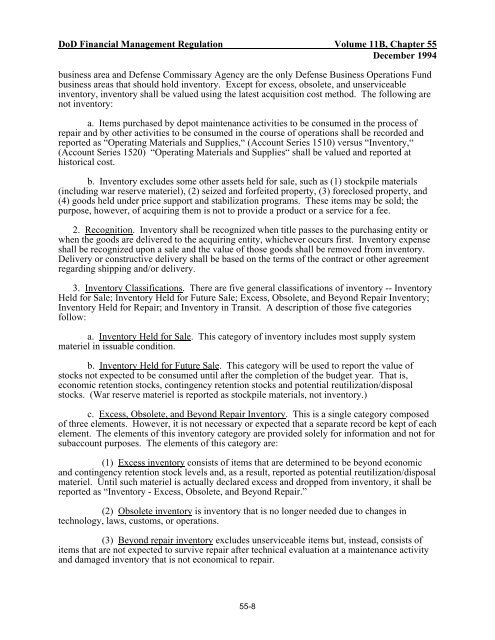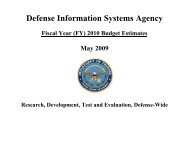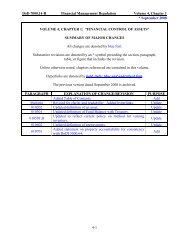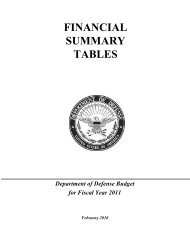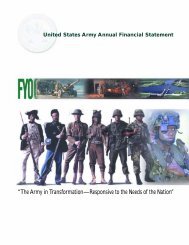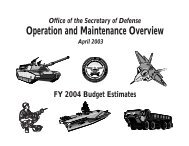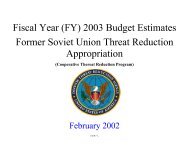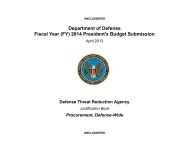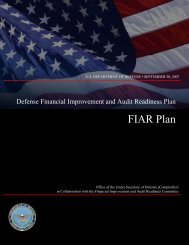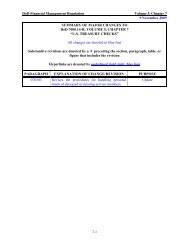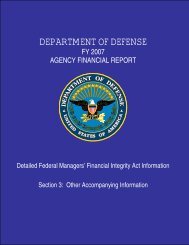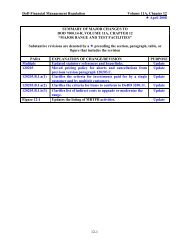Supply Management Operations - Comptroller
Supply Management Operations - Comptroller
Supply Management Operations - Comptroller
You also want an ePaper? Increase the reach of your titles
YUMPU automatically turns print PDFs into web optimized ePapers that Google loves.
DoD Financial <strong>Management</strong> Regulation Volume 11B, Chapter 55<br />
December 1994<br />
business area and Defense Commissary Agency are the only Defense Business <strong>Operations</strong> Fund<br />
business areas that should hold inventory. Except for excess, obsolete, and unserviceable<br />
inventory, inventory shall be valued using the latest acquisition cost method. The following are<br />
not inventory:<br />
a. Items purchased by depot maintenance activities to be consumed in the process of<br />
repair and by other activities to be consumed in the course of operations shall be recorded and<br />
reported as “Operating Materials and Supplies,“ (Account Series 1510) versus “Inventory,“<br />
(Account Series 1520) “Operating Materials and Supplies“ shall be valued and reported at<br />
historical cost.<br />
b. Inventory excludes some other assets held for sale, such as (1) stockpile materials<br />
(including war reserve materiel), (2) seized and forfeited property, (3) foreclosed property, and<br />
(4) goods held under price support and stabilization programs. These items may be sold; the<br />
purpose, however, of acquiring them is not to provide a product or a service for a fee.<br />
2. Recognition. Inventory shall be recognized when title passes to the purchasing entity or<br />
when the goods are delivered to the acquiring entity, whichever occurs first. Inventory expense<br />
shall be recognized upon a sale and the value of those goods shall be removed from inventory.<br />
Delivery or constructive delivery shall be based on the terms of the contract or other agreement<br />
regarding shipping and/or delivery.<br />
3. Inventory Classifications. There are five general classifications of inventory -- Inventory<br />
Held for Sale; Inventory Held for Future Sale; Excess, Obsolete, and Beyond Repair Inventory;<br />
Inventory Held for Repair; and Inventory in Transit. A description of those five categories<br />
follow:<br />
a. Inventory Held for Sale. This category of inventory includes most supply system<br />
materiel in issuable condition.<br />
b. Inventory Held for Future Sale. This category will be used to report the value of<br />
stocks not expected to be consumed until after the completion of the budget year. That is,<br />
economic retention stocks, contingency retention stocks and potential reutilization/disposal<br />
stocks. (War reserve materiel is reported as stockpile materials, not inventory.)<br />
c. Excess, Obsolete, and Beyond Repair Inventory. This is a single category composed<br />
of three elements. However, it is not necessary or expected that a separate record be kept of each<br />
element. The elements of this inventory category are provided solely for information and not for<br />
subaccount purposes. The elements of this category are:<br />
(1) Excess inventory consists of items that are determined to be beyond economic<br />
and contingency retention stock levels and, as a result, reported as potential reutilization/disposal<br />
materiel. Until such materiel is actually declared excess and dropped from inventory, it shall be<br />
reported as “Inventory - Excess, Obsolete, and Beyond Repair.”<br />
(2) Obsolete inventory is inventory that is no longer needed due to changes in<br />
technology, laws, customs, or operations.<br />
(3) Beyond repair inventory excludes unserviceable items but, instead, consists of<br />
items that are not expected to survive repair after technical evaluation at a maintenance activity<br />
and damaged inventory that is not economical to repair.<br />
55-8


